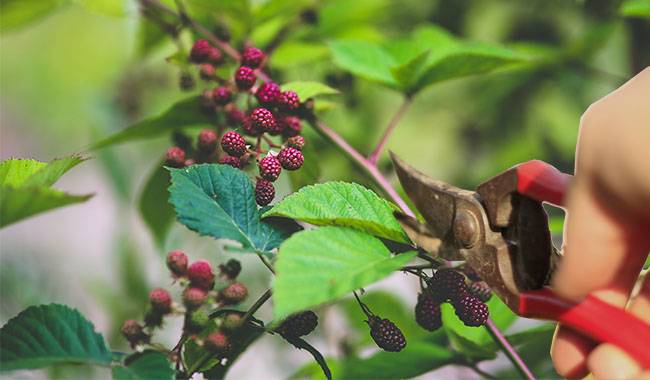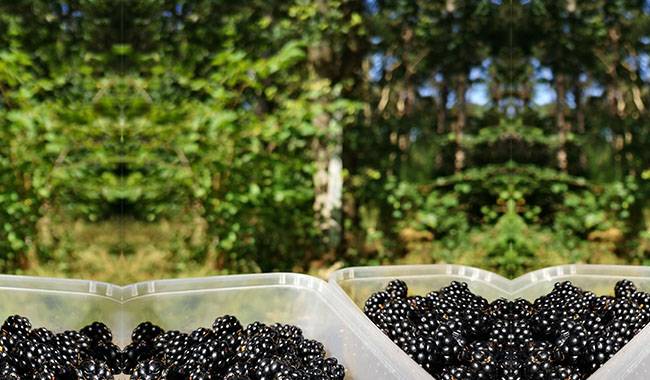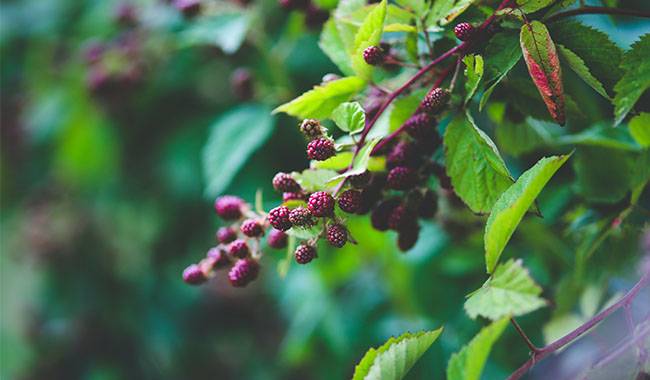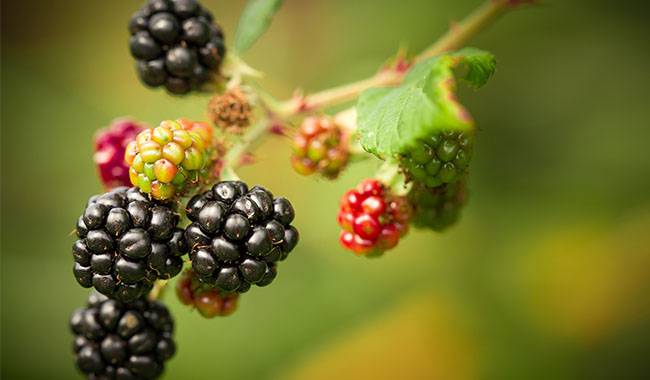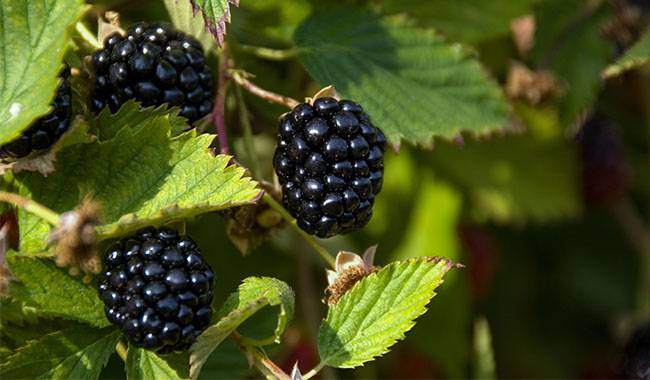
Blackberry is similar to raspberry except that its fruit first turns red and then charcoal black. To me, they have a more interesting taste than raspberries, but the seeds are more visible on the teeth.
Thanks to the work of plant breeders and the completely thornless varieties they have produced, and thanks to travelers and tourists who have brought new foreign varieties with high-quality fruit to our continent, blackberries are becoming more and more popular and can be seen more and more often on garden plots.
However, blackberries tend to grow well only on a trellis, which must be erected in the second year of planting on the plot. The trellis can be placed in the most primitive place. If you have a dozen varieties of blackberries on the plot, plant them with a distance of 6.5 feet (2 meters) between rows so that they do not interfere with each other.
At the edge of the rows, hammer in ordinary metal tubes of 5-6inch (12-15 cm) diameter, make holes in them, and stretch strong wire through them. From the second year on, you can hang blackberry shoots from the wire or twine. Throughout the summer you will be harvesting blackberries and when autumn comes you will be wondering what to do next and how to caring for blackberries!
Don’t worry: before you remove the blackberry from its stand and place it on a bed of soft leaves or wrap it up with it, you need to prune it hygienically and fertilize it, combined with hydration and moisturizing.
PRUNING BLACKBERRIES
There are many subtleties here. You must prune in such a way as to ensure the full growth and development of your blackberry plants later on. Of course, the first order of business is to remove all broken, dry, diseased shoots (no doubt about it), but what’s next?
Next, you need to relentlessly cut off all shoots that have already borne fruit this year. However, if you are a lucky resident of the southern United States, it is possible not to cut them off completely, but to shorten them to a height of 5 feet (1.5 meters).
All other blackberry shoots, in the current season, unfortunately, our harvest did not satisfy us and you need to prune, removing about 6-8inch (15-20 cm). Most likely, this immature part, even under mulch, will start to behave badly: it may freeze, start to rot, and decay.
Naturally, after such an event, all the cut blackberry shoots must be taken out of the area and be sure to burn them, the ashes can be put in a bag: it will come in handy. Let her eat a little, but it (we do not tire of repeating) contains potassium and trace elements that can be fed to, for example, houseplants.
FERTILIZING AND WATERING BLACKBERRIES
In what order to do these necessary procedures does not matter at all. Fertilize first and then water, or water first, and then spread the fertilizer on the moist soil – the way you think best.
WATERING BLACKBERRIES
Watering well is really just hydrating and moisturizing. If someone tells you he doesn’t water his blackberries at all and he has a luxurious yield every year, he is either lying or he has never seen a luxurious yield of blackberries at all.
In the first year after planting, when there is no trellis yet, you can only pour 3-4 buckets per square meter of soil. This is best done at the beginning of October when the soil is definitely not frozen yet and it is best to loosen it slightly beforehand. But remember, it should only be loosened slightly. The roots of blackberries must not be touched, and if the roots are damaged then they will start to grow and regrow shoots from the ground (usually with thorns, even if the original shoots did not have any thorns at all).
Plants that are still on the trellis, that is, the second and later years after planting, will of course need to be watered twice as much. This is fine. The water will soak deep into the soil and freeze slowly, without causing any damage to the roots. And, if there is a provocative winter thaw, the roots are unlikely to respond to it, and this thawing of blackberries will not cause any damage.
FERTILIZING BLACKBERRIES
After watering (let’s decide to do just that) fertilize. 50 grams per square meter of dry calcium superphosphate and 25 grams per square meter of potassium sulfate have proven to be the best for blackberries in the fall. You can also cover them with humus about 1 inch thick.
Important! Nitrogen fertilizer should not be applied in autumn, as this will stimulate the growth activity of the shoots and all of them will freeze, maybe even in the quilt.
The easiest thing is done, now it is necessary to carefully remove and cover the blackberry bushes from the trellis.
Important! Alas, but absolutely no damage to the blackberries can withstand frosts of a few tens of degrees Fahrenheit without exceeding a few tens of degrees Fahrenheit. Then already begin negative changes in the tissue, especially at the tips of the shoots. There have been cases where temperatures have dropped sharply from above 32°F (0°C) to slightly negative values, but within a very short period of time, e.g. within a few hours, resulting in death or severe frostbite of uncovered blackberry plants.
THE RIGHT TIME TO MULCH BLACKBERRIES
The most appropriate time is often the end of October (in the middle of the US) when it has started to freeze and you can’t wait for the warmth to arrive. The most dangerous thing is if the mulching will be followed by a week or even two weeks of really high temperatures or even rain, which can lead to blackberry rooting. For annuals, this is not fatal: from the root buds, the branches rejuvenate again like a bird’s “phoenix”. Of course, the gardener will lose the whole season, and if he makes repeated mistakes, he will lose the second season.
Here we must be guided by the indications of the weather stations, which sometimes tell us exactly when a steady cold spell is coming. And while we wait for the cold, you can treat blackberries with a 3% Bordeaux solution to rid the plants of winter stage pests and diseases.
As long as the temperature goes down below 32°F (0°C) and doesn’t even rise above 32°F (0°C) during the day, blackberry mulching is very possible. As we have already said, the period for mulching blackberries is usually in late October or early November in the central part of the U.S. However, this is in the middle of the country.
If you live farther south, you may not need mulch at all, or even be prohibited (shoots will be prohibited because inside, under mulch, a lot of completely unnecessary moisture accumulates, and if there is too much moisture, you can even start rotting the roots, and then the blackberries will die completely). If you live in the north, then you can start mulching a whole month earlier.
Therefore, before you mulch, you need to remember some important rules.
Rule #1: Blackberries can be ruined not only by a winter with no snow at all but also by a provocative thaw where frost suddenly turns to rain. In this case, the buds will freeze to death, so try to use extra, such as dried leaves, in addition to the main shelter, which can “take the hit”.
Rule #2: Do not rush to cover blackberries and wait for a light but steady frost, otherwise both roots and buds will simply uproot. As we have already mentioned, if you rush to cover, a lot of water will accumulate under it; in fact, a greenhouse effect will occur, which will damage the above-ground parts of the plant and the root system. In addition, due to the excess of water, various fungi and bacteria develop very actively. In this case, the shrub will regrow in spring, only if the above-ground part dies or if the top is a bit podgy, but if the roots are affected, the site will have to be laid again.
Rule #3: If you live in a western area where the thermometer doesn’t go below 14°F (-10°C) in the winter, forget about mulching or use a single layer of agricultural fabric, which “breathes”.
Those who have mulched their grapes will find it easier, while those who have not will find it more difficult. Blackberry branches, very carefully so as not to break, should be removed from their supports, wire, and placed on the surface of the soil that has been taken by frost, and gently pinned to them. If the bush is large, tie them together with twine before laying.
To exclude the blowing of blackberries, or at least minimize it, it is necessary to cover the shoots already laid on the surface of the soil with dry leaves (or lay branches on top of them, sprinkled with leaves in advance), and afterward with a soil mulch film, something that should be fixed and not tear the wind. This can be bricks on the edge, crates, plywood, etc.
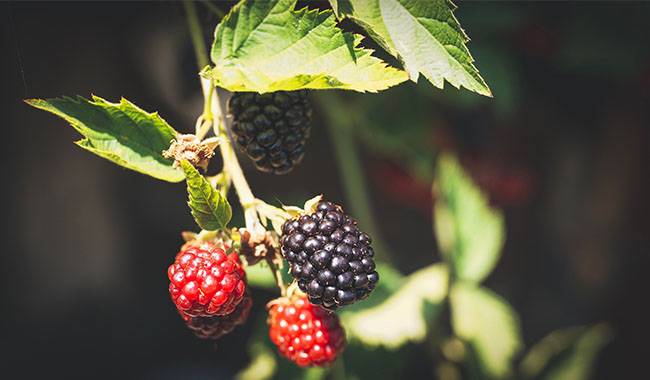
THE PERFECT MULCHING MATERIAL
Gardeners have debated, are debating, and will continue to debate what is the best mulching material for blackberries. Some try to mulch with film, others use agricultural fabrics exclusively, but trust me, whichever way you choose, it still has pros and cons.
Take film for example: if you live in the middle of the country, that’s fine, but if you’re near the south, obviously the temperature changes in the winter can create condensation under the film, leading to the consequences mentioned above. If you have decided to use film, or if you don’t have anything else handy, you can use a layer between the plants and the film, for example, a mulch, as in a layer of moss – with double protection: against moisture and against frost.
Then there are agro textiles, a relatively new non-woven material that has perfect permeability to water and air (they “breathe”). Even during the thawing period (which occurs in autumn and winter), agro textiles show their good side: they let water pass through and allow it to evaporate.
However, if there is too much water (i.e. active snowmelt in mid-winter), it cannot cope with the evaporation of excess water and it thaws. Therefore, in areas where thawing is active, you better warn yourself and use fir wood, corn, or at least dry leaves covered with twigs or branches.
If you have to choose between light and black wool, it is better to choose light wool, because black wool gets very hot in spring (if you live in the city and your blackberries are in a country house, when you go to the country house it will be cooked under black wool).
It is recommended for northerners to use sintepon synthetic mulch film, but it should not be placed on the plant, but on pre-layered leaves, dry and free from all kinds of diseases. However, in warm winters with low snow, plants in northern areas may suffer under this type of mulch.
MISTAKES WHEN MULCHING BLACKBERRIES
The first mistake: is not appearing under the cover of the poison of mice (believe me, they eat all the buds).
The second mistake: is using sawdust as insulation for blackberries. They absorb moisture very quickly, turn into just a block of ice, and then melt very slowly. I personally found a piece of ice as late as July in a pile of sawdust. What’s wrong with that? Blackberries don’t warm up in the spring, they slowly wilt under the ice and rocks instead.
The third mistake: is using straw for mulch. Straw actively attracts rodents, who settle in it, build “apartment buildings” and live there, eating blackberry buds and nibbling on shoots, and in spring it is not easy to remove all the semi-digested winter straw from the site.
The fourth mistake: is delaying the removal of mulch material. Remember to run to the site as soon as the snow melts and the temperature rises to remove the mulching material: a strong frost will not, but a thaw may occur. Make sure you remove the mulching material before the buds on the blackberries swell.
Basically, there is nothing particularly complicated: a dozen shrubs, primitive trellis, no less primitive shelter, and the main thing – all the time and at the same time, do not forget the rodents.




